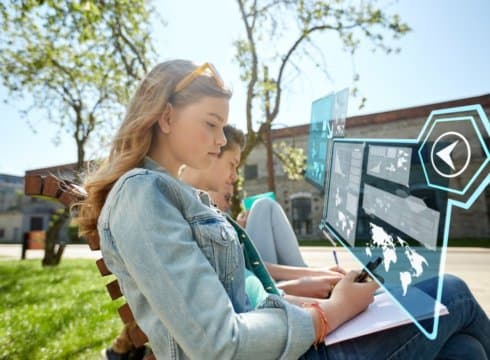Inc42 Daily Brief
Stay Ahead With Daily News & Analysis on India’s Tech & Startup Economy
The Indian educational landscape is fast-changing with technology gripping the nation in an unprecedented fashion. A lifestyle comparison between current times and half a decade ago shows us how the general scheme of things has metamorphosed. Today, as we go on shopping sprees without visiting the nearest mall, have a face-to-face video conversation with a distant friend or even complete bank transactions without ever visiting a branch, we realise that we have undoubtedly travelled a great distance into the realm of technology. The education sector has not remained untouched by this development.
An ultra-modern mixture of education and technology is also coming to the surface.
Academic Challenges Faced By India
Education in India still exhibits significant regional disparities. Observations show us that a majority of Indian educators employ traditional teaching techniques which have, by far and large, failed to meet student requirements; especially in the modern landscape. Despite this evident drawback, the status quo is further affected by the number of teachers allocated to students. The ideal Pupil-Teacher Ratio for schools is 1:30 for primary and 1:35 for upper primary sections.
In reality though, this number is skewed to 1:65 or even 1:70. Not only does this decrease a teacher’s capability to focus individually on students, it also significantly deters a student’s academic progression. Every student has a unique set of requirements. One, who is good with retention, might need a teacher’s help to better their analytical skills; while another, who understand topics easily, might need constant revision.
A student might even require a specific teaching pattern to understand and retain a specific concept better. The sad reality, is that meeting individual student requirements – within a class of even 30 students – is nearly impossible. In addition, every student has to follow the average classroom velocity – which differs considerably from the individual learning capacities of the highest and lowest scoring student. Most regions are also affected by the inconsistent quality of teachers deployed. Students often have to travel a great distance to acquire quality education.
This not only exhausts them considerably, but also poses a security concern for their parents. Students worst affected by this problem, are those living in remote regions. Unlike their urban counterparts, they have access to neither decent schools nor state-of-the-art learning pedagogies. Acquiring the desired study material is also a big challenge in these regions.
Changing The Academic Landscape
To address these problems, new-age digital platforms are using technology to enhance the academic landscape in our country. By leveraging evolved multimedia formats, these platforms are allowing students to grasp academic concepts better.
The use of machine learning and artificial intelligence gives them the ability to adopt a personalised approach that considers individual unique learning patterns to further enhance a student’s learning experience. This is done with clinical precision so that students don’t have to mandatorily follow the average classroom velocity and can instead learn concepts at speeds they’re most comfortable with.
Digital platforms also offer better insights into the academic progress of a student. Their proprietary algorithms are often capable of analysing student-generated data to precisely evaluate individual skillsets and academic weaknesses. They then make the best use of their skills while also extending a superlative strategy to counter their limitations.
This gives students an ideal learning environment which meets their specific needs and allows them to achieve the most favourable results. By leveraging technology, adaptive practise sessions assess students’ strengths and weaknesses, for each particular topic, to give them an efficient way to progress in their academics. Another aspect that students benefit from, is the ability of digital platforms to provide consistent and good quality content anytime, anywhere. These platforms also guarantee the availability of academic experts for doubt resolutions throughout the day. This ensures that a student’s preparations are never held back at any point in time.
The availability of educational content on-the-go also saves students from lagging behind the average academic pace they need to follow, even when travelling. All these advantages are bettering the prospects of students across the country. Edtech platforms are actively making a qualitative and quantitative difference to education in India. They are unlocking advanced learning methodologies for students, across regions, in the comfort of their homes.
When plugged in with regular classroom courses, such platforms can greatly enhance a student’s performance. With the constant evolution of technology, a problem that has long since plagued independent India for far too long is being alleviated. The emergence of edtech platforms in the Indian landscape is eliminating barriers to quality education in favour of a brighter, more learned future.
{{#name}}{{name}}{{/name}}{{^name}}-{{/name}}
{{#description}}{{description}}...{{/description}}{{^description}}-{{/description}}
Note: We at Inc42 take our ethics very seriously. More information about it can be found here.


